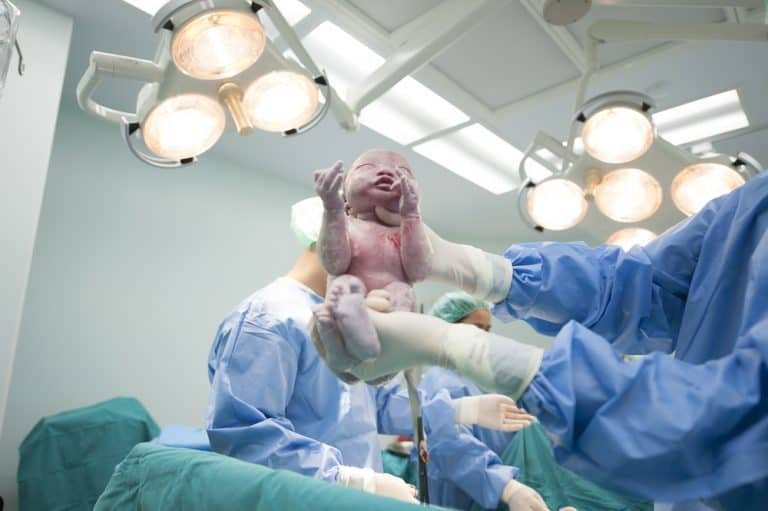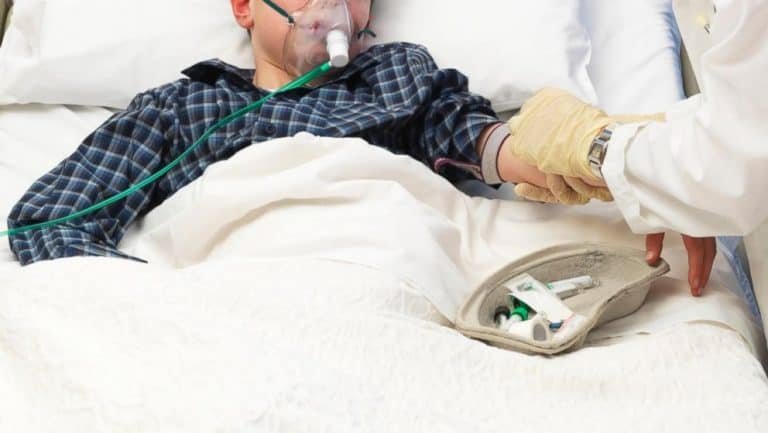Real Risks of Cesareans
A C-section is major abdominal surgery that requires anesthesia. A six-inch incision is cut through the skin, fascia (fibrous tissue surrounding muscles and other organs), abdominal lining, and the thick uterine muscle. The abdominal six-pack muscles need to be separated surgically. There are many risks and potential dangers for mom and baby from the surgery and anesthesia.
The Worst Time for Unneeded Surgery
Surgery adds stress and is only warranted if it increases safety. Women, who have just given birth, are undergoing radical transformations on every level of their being. Physical, psychological, emotional, spiritual, social and career changes are affecting them, their partner and family. Women also need energy to bond with their baby and initiate the breastfeeding relationship. Unnec-cesareans add a huge stress to this already complex mix, can tip the balance and complicate a woman and her baby’s life for years to come.
Common Maternal Risks
Double the blood loss, compared to normal vaginal birth. Routine blood loss with surgical birth is one quart or one liter.[1]
Abdominal scarring
Severe pain after the birth requires narcotics and other medications
Disruption of the “Golden Hour.” The first hour after a normal vaginal birth is an intense peak experience for mother & baby that will never be experienced again. Cesarean delivery interferes with a mother’s ability to: receive her baby; have skin-to-skin contact with her newborn; focus on her baby since she is undergoing surgery and maybe experiencing negative side effects; be with her baby since the baby is usually taken to the nursery until surgery is completed and/or the mother is released from the recovery room.
Breastfeeding challenges and delayed breastfeeding[2]
Inability to independently care for infant for several days
Complex medical care. The new mother will be attached to an EKG machine, IVs, urinary catheter, as well as requiring assistance to move and to get out of bed. Skin staples will be removed before the mother is discharged from the hospital. The mother will need to be seen in the obstetrician’s office at 2 weeks following surgery for an incision check.
Antibiotic exposure is routine after Cesarean delivery and can disturb the mother’s natural flora (healthy bacteria in the body). Can result in more vaginal yeast infections.
Anemia (lower level of red blood cells, which can result in fatigue and weakness
Infections including in her wound & urinary tract infections from urinary catheters (3)
Hemorrhage (bleeding), leading to more transfusions or hysterectomy (removal of uterus)
Longer hospital stays and recovery time than with vaginal birth. The new mother needs more help at home.
Internal scar tissue (adhesions) can make future C-sections more complicated.
Dangerous blood clots occur 3 to 4 times more frequently than with vaginal birth.
Pneumonia
Abdominal muscle damage
Re-hospitalizations for complications
Bladder or bowel damage, such as blockage or paralysis of the bowel (3)
Increased early postpartum depression is possible, especially if the woman doubts that the C-section was necessary, or she strongly wanted to avoid one. Negative perceptions of birth can affect relationship with newborn (4-8) Women often need to grieve the loss of normal birth. Mothers may feel less positive about their newborns and may be less confident of their own ability to care for their infants. Psychological reactions of the mothers can be more intense if the women believed that the C-sections were not needed.
Oriental medicine concerns. C-sections sever 3-4 meridians (energy lines of the body) and result in stagnation of chi or life force
Limited number of children. Maximum of 3 C-sections is generally recommended
May lead to future surgery not related to childbirth.
Future Pregnancy Risks
Uterine rupture, leading to emergency surgery, hemorrhage, and possible fetal damage or fetal death.
Placenta previa (in which the placenta blocks delivery). In future pregnancies, the placenta can cover the uterus, resulting in excessive bleeding and repeat C-sections.
Dreaded placenta accreta (a medical emergency in which the placenta grows into the uterine tissues and needs to be surgically removed). Placenta accreta often is associated with hemorrhage and can lead to hysterectomy.
Future abdominal or pelvic pain due to adhesions.
Stillbirth, premature birth, slow fetal growth11
Rarer Risks
Intensive care unit admissions.12
Painful endometriosis– inner uterine lining escapes and grows outside the womb.13
Opiate use disorders can be triggered by narcotics ordered when the woman goes home after a C-section.14 My sister developed narcotic addiction after a hysterectomy.
Possible future infertility.15
Abnormal vaginal bleeding through a “hole” in the scar that leaks into the vagina when the menstrual period returns is not common, but has been proven by ultrasound exams.16
Amniotic fluid embolism (AFE) is a deadly but very rare, life threatening emergency that occurs 2-5 times more frequently with C-sections.17, 18 Maternal mortality from AFE in the US is 61. Gratefully, I have never seen a case in my entire career.
Common Newborn Risks
Breathing difficulties.19 I have cared for many routine cesarean born babies in respiratory distress. Labor prepares a baby for breathing. Cesarean babies do not experience the normally designed “birth canal squeeze,” which clears fluid from the baby’s lungs. Breathing problems will be worse if there was no labor.
Altered bonding process with the mother
Delayed breast-feeding
Breastfeeding difficulties, with possible long-term health consequences for the child.2
More jaundice from delayed feeding can lead to more newborn interventions. 20
Altered immune development.21, 22 Birth in a sterile operating room lessens exposure to the mother’s “good” bacteria, which otherwise would occur during vaginal birth. This problem will be amplified if the mother does not undergo labor.
Childhood allergies, asthma, and autoimmune disease that are increasingly found in developed countries may result from altered immunity.22, 23
Increased childhood obesity and type 1 diabetes.21, 23
Intensive care nursery admissions are greater when babies are born by planned Cesareans after previous C-sections, compared to that of babies born vaginally after previous Cesareans (VBAC).19, 23
More childhood hospital admissions. 2
Loss of normal birth experience. Osteopathic physicians and cranio-sacral specialists are concerned with the effects of the abruptness of delivery.25 Skull constrictions can result from the baby not going through the birth canal and not experiencing normal skull compression and then decompression.25, 26
Risks we are not aware of yet.
Less Common Newborn Risks
Persistent pulmonary hypertension (high blood pressure in the blood vessels of the lungs)19
Possible behavioral issues. Perinatal psychology is a growing field. Psychologists are increasingly aware that birth experiences are stored in the infant’s subconscious, which can affect later attitudes and behavior. We know that adults can access their birth memories.8, 27 Babies born by C-section may exhibit excessive crying, feeding difficulties, hyper-alertness, sleeping difficulties, digestive issues such as food allergies and colic, and defensiveness to touch. The abruptness of surgical birth can lead to psychological shock. Infants born by Cesarean may develop invasion/control complex.28, 29
Negative $$$$$$ Effects
Double the cost of the birth for an uncomplicated C-section. The additional complications associated with delivery by abdominal incision make such births even more expensive and can lead to higher out-of-pocket costs and eventually more expensive insurance premiums and taxes.30
The overuse of technology in maternity care is wasteful and one of the greatest expenses in U.S. healthcare. The U.S. spends more money and big businesses makes more money but we have embarrassing rankings than the other developed nations. How much of your tax dollars get wasted on unwise maternity care spending?
Rejected insurance applications for women who applied for coverage have been reported because of a previous Cesarean.30









